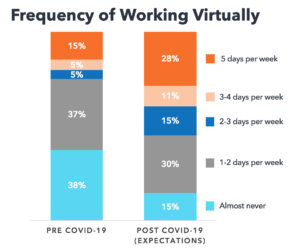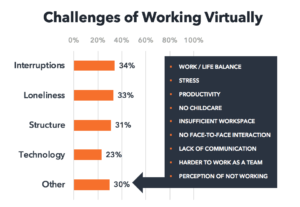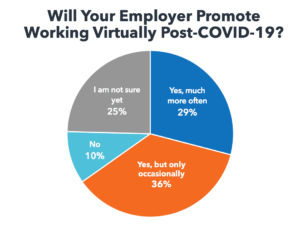What is the Future of Virtual Work?
With the sudden shift to remote work, millions of people around the world are taking part in an unprecedented WFH experiment. With both benefits and challenges—what will the future of work look like after COVID-19?
“There is no such thing yet as a new normal. Nobody has the faintest idea of what the new normal looks like.” Unilever CEO Alan Jope.
Since most of us are not clairvoyant, we are thankful that data can help us discern possible trends. Madison Wells recently released a report detailing the impact that COVID-19 has had on the Market Research and Advanced Analytics industries. The information gleaned has illuminated our understanding of the current landscape—and where it may be headed.
Even before the current pandemic, the move towards increased work from home had been growing at a steady clip. Gallup data from 2016 showed that 43% of the American workforce works at home at least some of the time. And according to the most recent American Time Use Survey by the Bureau of Labor Statistics, 57% of workers in 2018 had a flexible schedule.
Now that so many of us have become part of an unwitting experiment in working virtually, what will work look like going forward?

VIRTUAL WORK POST-COVID: THE BENEFITS
Double is the name of the game from the data we collected from our survey. Almost twice the number of respondents feel that they will be working from home five days a week going forward as compared to pre-COVID-19 days—that means that nearly a third of those we surveyed project that they will be 100% WFH in the future. 54% of respondents expect to work virtually two or more days post-pandemic, compared to 25% that previously worked two or more days from home—another doubling from pre-COVID days.
Here’s why WFH works well for so many people:
- Increased desire for the work/life balance and flexibility. Before the pandemic, research showed that up to 80% of employees wanted to work from home at least some of the time—and a third said that they would take a pay cut in exchange for the ability to WFH more.
- No commute makes for better work efficiency. Studies show that 78% of employees report that they want to WFH in order to avoid a commute, and it’s not hard to see why. It now takes the average worker 52 minutes to travel to work roundtrip, according to the U.S. Census Bureau—the longest it’s been since the Census began tracking this data in 1980. To put this in context: if you commute to a full-time, 5-day-a-week job, that adds up to 4.35 hours a week and over 200 hours—or nearly nine days—per year (And this number climbs north depending on where you live. Round trip commutes in Washington D.C. average one hour and 27 minutes, and in New York, an hour and 10 minutes).
- Increased productivity, better focus—and less stress. Many people report far lower levels of stress when they work from home as compared to when they commute daily to an office, and data shows that 79% feel more productive when they work from home.
- Positive impact on sustainability. From the early days of the global WFH experiment, the dramatic reduction in traffic, pollution, and congestion have been remarkable. While sustainability has not been a primary driver of remote work, being able to see tangible evidence of its impact may solidify the connection and value for both employers and employees.

VIRTUAL WORK POST-COVID: THE CHALLENGES
While remote work has many benefits for employees, it is not without its challenges. Insights and data suggest that working virtually full-time today is not a true reflection of productivity post-COVID-19. Parents are without childcare, entire families are working in the same space (impacting both nerves and WiFi), and the environment is more chaotic and stressful than under normal (non-pandemic) circumstances.
Having said that, many respondents still feel that there are some endemic challenges to WFH, among them:
- Interruptions and distractions. More than a third of those surveyed report that disruptions are a significant drawback to being able to successfully WFH. Even under more optimal circumstances, staying productive can be a challenge for some people when not in an office environment—and not having a dedicated workspace at home can make distractions more difficult to ignore.
- Loneliness. A third of our survey respondents pointed to feelings of isolation as being one of their major challenges with WFH. Humans are social, and some of us thrive from increased interaction with other people. Without a physical point of connection, remote workers can get lonely. Videoconferencing can help—more for some than for others—but it’s not the same as face-to-face interaction.
- A lack of structure. 31% shared that working from home has led to less supervision and a loss of direction. With less guidance from managers, many employees struggle to stay on track.
- Inadequate technology. 23% feel unprepared in terms of technology to WFH—and without well-functioning tech, remote work does not Temperamental laptops, intermittent WiFi, and uncooperative cameras are just some of the tech challenges reported by our survey respondents.
Communication remains a crucial challenge with remote work. Humans rely on both verbal and nonverbal communication cues when speaking—but emails, phone calls, and even video chats can remove much of the nuance from how we interact with one another. However, numerous planned check-ins, utilization of collaborative work management tools like Trello or Slack, and more crystallized, codified structure can help compensate for the lack of in-person connectivity.

WILL YOUR COMPANY PROMOTE WORKING VIRTUALLY POST COVID-19?
What we found through our survey is that employers are of two minds when it comes to calibrating post-COVID-19 plans. One camp believes that this pandemic provides evidence that teams can be more efficient and effective at home—potentially rendering the traditional 5-day-a-week traditional office schedule a thing of the past. The other camp believes that this quarantine has reinforced the importance of an office environment, which they feel fosters collaboration, team building, innovation, and engagement.
Employees are similarly split on what to expect post-COVID. Many have indicated that they miss the camaraderie of the office environment and anticipate reporting back to an office on some level. Others would like to have the autonomy of balancing work/home life by utilizing office space when safe/necessary while continuing to work from home the majority of the time.
Here are some key work insights from our survey data:
- 65% expect employers to promote working virtually—but only 29% believe it will be much more often.
- Over 50% believe their employers will afford additional day(s) to work remotely at least initially for a myriad of reasons.
- 25% were uncertain if working from home would increase post-COVID-19, which makes sense as opinions and mandates are changing daily.
THE FUTURE OF WORK: WHAT WILL THE NEXT NORMAL LOOK LIKE?
There are considerable cost-saving opportunities in promoting increased remote work for both employers and employees—which takes on added significance in the face of a recession. In the words of Dirk Van de Put, CEO of Mondelez International: “The crisis has shown that we can work in different ways and maybe we don’t need all the offices that we currently have around the world.”
We suspect that the new normal might fall somewhere in the middle with regards to working virtually vs. in-office. Based on conversations, a resounding theme seems to be that enacting some type of staggered re-entering into the office is likely. Perhaps critical workers first, potential “block” schedules to ensure offices and lobbies are not overcrowded, along with comprehensive testing programs, and adjustments to “open offices” to comply with social distancing mandates. However, if more people end up working remotely, companies may opt to open regional hubs or provide access to co-working spaces in places where their employees are concentrated as opposed to having the majority of their workforce operate from a central office.
To add some more intrigue to the mix, a number of prominent companies—including Facebook, Google, and Zillow—have announced that most of their employees will remain working from home until 2021. And Jack Dorsey, chief executive of Twitter, told employees that they would not be expected to return to the company’s offices and could work remotely forever if they wanted. But not all tech companies are embracing remote work: Apple has taken a different approach—and plans to bring employees back to its global offices in stages, with the first tranche slated to return between May and June.
The one thing we know for certain about the future of work post-COVID-19 is that it will not look like it did just eight weeks ago. Innovation often flourishes in the face of great constraint, and this pandemic has erected extraordinary barriers to business as usual. The struggles that have ensued are pushing new ways of thinking and fresh perspectives on solving problems, which could lead to better approaches and outcomes going forward.

